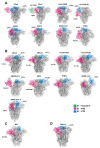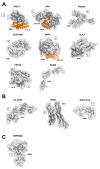Known Cellular and Receptor Interactions of Animal and Human Coronaviruses: A Review
- PMID: 35215937
- PMCID: PMC8878323
- DOI: 10.3390/v14020351
Known Cellular and Receptor Interactions of Animal and Human Coronaviruses: A Review
Abstract
This article aims to review all currently known interactions between animal and human coronaviruses and their cellular receptors. Over the past 20 years, three novel coronaviruses have emerged that have caused severe disease in humans, including SARS-CoV-2 (severe acute respiratory syndrome virus 2); therefore, a deeper understanding of coronavirus host-cell interactions is essential. Receptor-binding is the first stage in coronavirus entry prior to replication and can be altered by minor changes within the spike protein-the coronavirus surface glycoprotein responsible for the recognition of cell-surface receptors. The recognition of receptors by coronaviruses is also a major determinant in infection, tropism, and pathogenesis and acts as a key target for host-immune surveillance and other potential intervention strategies. We aim to highlight the need for a continued in-depth understanding of this subject area following on from the SARS-CoV-2 pandemic, with the possibility for more zoonotic transmission events. We also acknowledge the need for more targeted research towards glycan-coronavirus interactions as zoonotic spillover events from animals to humans, following an alteration in glycan-binding capability, have been well-documented for other viruses such as Influenza A.
Keywords: SARS-CoV-2; cleavage; coronavirus; glycan; haemagglutinin-esterase; host interaction; omicron; receptor-binding; sialic acid; spike protein.
Conflict of interest statement
The authors declare no conflict of interest.
Figures










Similar articles
-
SARS-CoV-2 Evolutionary Adaptation toward Host Entry and Recognition of Receptor O-Acetyl Sialylation in Virus-Host Interaction.Int J Mol Sci. 2020 Jun 26;21(12):4549. doi: 10.3390/ijms21124549. Int J Mol Sci. 2020. PMID: 32604730 Free PMC article. Review.
-
Inhibition of SARS-CoV-2 viral entry upon blocking N- and O-glycan elaboration.Elife. 2020 Oct 26;9:e61552. doi: 10.7554/eLife.61552. Elife. 2020. PMID: 33103998 Free PMC article.
-
SARS-CoV-2 and other coronaviruses bind to phosphorylated glycans from the human lung.Virology. 2021 Oct;562:142-148. doi: 10.1016/j.virol.2021.07.012. Epub 2021 Jul 23. Virology. 2021. PMID: 34325286 Free PMC article.
-
Broad and Differential Animal Angiotensin-Converting Enzyme 2 Receptor Usage by SARS-CoV-2.J Virol. 2020 Aug 31;94(18):e00940-20. doi: 10.1128/JVI.00940-20. Print 2020 Aug 31. J Virol. 2020. PMID: 32661139 Free PMC article.
-
A Review of Human Coronaviruses' Receptors: The Host-Cell Targets for the Crown Bearing Viruses.Molecules. 2021 Oct 26;26(21):6455. doi: 10.3390/molecules26216455. Molecules. 2021. PMID: 34770863 Free PMC article. Review.
Cited by
-
SARS-CoV-2 Attacks in the Brain: Focus on the Sialome.Cells. 2022 Apr 26;11(9):1458. doi: 10.3390/cells11091458. Cells. 2022. PMID: 35563764 Free PMC article. Review.
-
Viral envelope proteins fused to multiple distinct fluorescent reporters to probe receptor binding.Protein Sci. 2024 Apr;33(4):e4974. doi: 10.1002/pro.4974. Protein Sci. 2024. PMID: 38533540 Free PMC article.
-
Receptor Binding for the Entry Mechanisms of SARS-CoV-2: Insights from the Original Strain and Emerging Variants.Viruses. 2025 May 10;17(5):691. doi: 10.3390/v17050691. Viruses. 2025. PMID: 40431702 Free PMC article. Review.
-
Plasmablasts in previously immunologically naïve COVID-19 patients express markers indicating mucosal homing and secrete antibodies cross-reacting with SARS-CoV-2 variants and other beta-coronaviruses.Clin Exp Immunol. 2023 Jul 21;213(2):173-189. doi: 10.1093/cei/uxad044. Clin Exp Immunol. 2023. PMID: 37071584 Free PMC article.
-
Protective neutralizing epitopes in SARS-CoV-2.Immunol Rev. 2022 Sep;310(1):76-92. doi: 10.1111/imr.13084. Epub 2022 May 22. Immunol Rev. 2022. PMID: 35599305 Free PMC article. Review.
References
-
- King A.M., Lefkowitz E., Adams M.J., Carstens E.B. Virus Taxonomy: Ninth Report of the International Committee on Taxonomy of Viruses. Volume 9 Elsevier; Amsterdam, The Netherlands: 2011.
-
- Walker P.J., Siddell S.G., Lefkowitz E.J., Mushegian A.R., Adriaenssens E.M., Dempsey D.M., Dutilh B.E., Harrach B., Harrison R.L., Hendrickson R.C., et al. Changes to virus taxonomy and the Statutes ratified by the International Committee on Taxonomy of Viruses (2020) Arch. Virol. 2020;165:2737–2748. doi: 10.1007/s00705-020-04752-x. - DOI - PubMed
-
- Beaudette F. Cultivation of the virus of infectious bronchitis. J. Am. Vet. Med. Assoc. 1937;90:51–60.
-
- Doyle L.P., Hutchings L.M. A transmissible gastroenteritis in pigs. J. Am. Vet. Med. Assoc. 1946;108:257–259. - PubMed
Publication types
MeSH terms
Substances
Grants and funding
- BB/M011224/1/BB_/Biotechnology and Biological Sciences Research Council/United Kingdom
- BBS/E/I/00007031/BB_/Biotechnology and Biological Sciences Research Council/United Kingdom
- BBS/E/I/00007034/BB_/Biotechnology and Biological Sciences Research Council/United Kingdom
- BBS/E/I/COV07001/BB_/Biotechnology and Biological Sciences Research Council/United Kingdom
LinkOut - more resources
Full Text Sources
Miscellaneous

